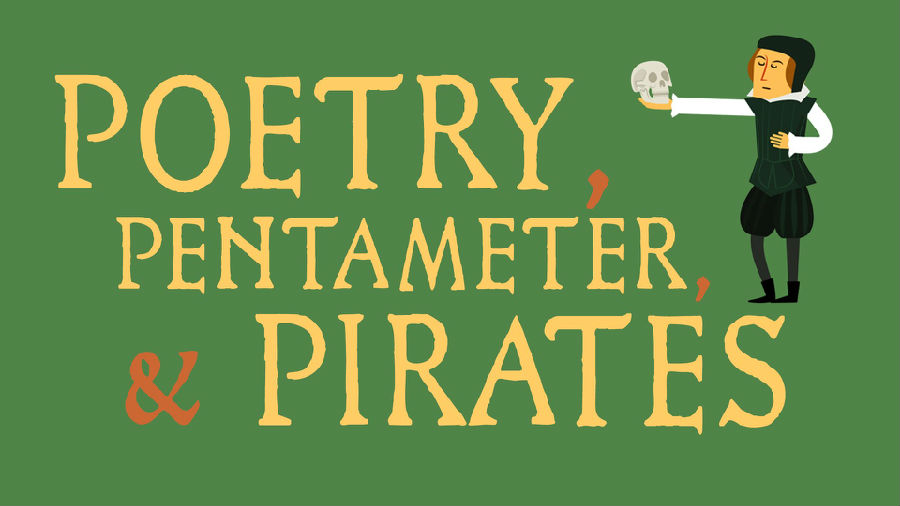(单词翻译:单击)
To someone first encountering the works of William Shakespeare, the language may seem strange.
对于第一次阅读莎士比亚的作品的人来说,他的用语可能有些奇怪。
But there is a secret to appreciating it.
但是欣赏他的作品有一个秘诀。
Although he was famous for his plays, Shakespeare was first and foremost a poet.
虽然他以戏剧闻名,但莎士比亚首先是一位诗人。
One of the most important things in Shakespeare's language is his use of stress.
莎士比亚的语言中最重要的一点是他的强调音。
Not that kind of stress, but the way we emphasize certain syllables in words more than others.
不是那种强调,是强调单词中的某些音节。
We're so used to doing this that we may not notice it at first.
我们已经习惯这样做了,以至于我们察觉不出来。
But if you say the word slowly, you can easily identify them.
但是如果你慢慢地读一个单词,你能听得出来。
Playwright, computer, telephone.
剧作家,计算机,电话。
Poets are very aware of these stresses,
诗人很注重这些重音,
having long experimented with the number and order of stressed and unstressed syllables,
他们长期实验各种重音节和轻音节的个数和顺序,
and combined them in different ways to create rhythm in their poems.
用不同的组合方式去产生诗歌中的韵律。
Like songwriters, poets often express their ideas through a recognizable repetition of these rhythms or poetic meter.
像曲作家一样,诗人通过重复一个可识别的节奏来表达它们的想法,这就叫韵律。
And like music, poetry has its own set of terms for describing this.
像音乐一样,诗歌有特殊的术语描述这些韵律。
In a line of verse, a foot is a certain number of stressed and unstressed syllables forming a distinct unit,
在一行诗中,音步是一定量的重音节和轻音节组成了一个独立的单位,
just as a musical measure consists of a certain number of beats.
就像音乐中不同的节拍含有不同数量的拍子。
One line of verse is usually made up of several feet.
一行诗通常有好几个音步。
For example, a dactyl is a metrical foot of three syllables with the first stressed, and the second and third unstressed.
比如,一个长短格是一个带三个音节的音步,第一个音节是重音节,后两个是轻音节。
Dactyls can create lines that move swiftly and gather force, as in Robert Browning's poem, 'The Lost Leader.'
长短格可以创造出流畅有力的诗句,就像罗伯特·布朗宁的诗歌《失落的领袖》,
'Just for a handful of silver he left us. Just for a rib and to stick in his coat.'
“只为了一把银钱他离开了我们,只为了一条缎带綴在他的衣裳。”
Another kind of foot is the two-syllable long trochee, a stressed syllable followed by an unstressed one.
另一种音步是长达两音节的扬抑格,第一个重音节,接着一个轻音节。
The trochees in these lines from Shakespeare's 'Macbeth' lend an ominous and spooky tone to the witches' chant.
莎士比亚的《麦克白》中的扬抑格赋予了女巫的咒语一种不祥和怪异的感觉。
'Double, double, toil and trouble; fire burn and cauldron bubble.'
“不惮辛劳不惮烦,釜中沸沫已成澜。”
But with Shakespeare, it's all about the iamb.
但是莎士比亚使用的是抑扬格。
This two-syllable foot is like a reverse trochee,
这个长达两个音节的音步和扬抑格恰好相反,
so the first syllable is unstressed and the second is stressed, as in, 'To be, or not to be.'
所以第一个是轻音节,第二个是重音节,比如“生存还是毁灭。”
Shakespeare's favorite meter, in particular, was iambic pentameter,
莎士比亚尤其喜欢的音步是五步抑扬格,
where each line of verse is made up of five two-syllable iambs, for a total of ten syllables.
每行诗是由五个两音节抑扬格组成的,总共十个音节。
And it's used for many of Shakespeare's most famous lines: 'Shall I compare thee to a summer's day?'
许多莎士比亚的名句都是使用这个音步的:“我能否把你比作夏日璀璨?”
'Arise fair sun, and kill the envious moon.'
“升起吧,美丽的太阳!赶走那嫉妒的月亮。”

Notice how the iambs cut across both punctuation and word separation.
我们可以看到抑扬格是不管标点符号或单词长短的。
Meter is all about sound, not spelling.
音步是看音,而不是拼写。
Iambic pentameter may sound technical, but there's an easy way to remember what it means.
五步抑扬格可能听上去很专业,但是有一个很简单的方法就能记住它的含义。
The word iamb is pronounced just like the phrase, 'I am.'
“抑扬”的发音很像“我是”。
Now, let's expand that to a sentence that just happens to be in iambic pentameter.
现在,把它扩展成一个正好是五步抑扬格的句子。
'I am a pirate with a wooden leg.'
“我是一个有木腿的海盗”。
The pirate can only walk in iambs, a living reminder of Shakespeare's favorite meter.
这个海盗只能一步一步地走,可以联想到莎士比亚最喜欢的音步。
Iambic pentameter is when he takes ten steps.
五步抑扬格是他走完了十步。
Our pirate friend can even help us remember how to properly mark it
这个海盗还可以帮我记住里面的轻重音节,
if we image the footprints he leaves walking along a deserted island beach:
如果我们想象他在沙滩上留下的脚印:
A curve for unstressed syllables, and a shoe outline for stressed ones.
曲线代表轻音节,鞋印代表重音节。
'If music be the food of love, play on.'
“如果音乐是爱情的食量,那就继续演奏吧。”
Of course, most lines of Shakespeare's plays are written in regular prose.
当然,莎士比亚戏剧里大多数的台词都是普通的散文。
But if you read carefully, you'll notice that Shakespeare's characters turn to poetry,
但是如果你仔细阅读,你会发现莎士比亚的文字变成了诗歌,
and iambic pentameter in particular, for many of the same reasons that we look to poetry in our own lives.
尤其是五步抑扬格,就像我们欣赏我们生活中的诗歌一样。
Feeling passionate, introspective, or momentous.
感觉到激情、内省或峥嵘。
Whether it's Hamlet pondering his existence, or Romeo professing his love,
无论是哈姆雷特思索他存在的意义,或是罗密欧表述他的爱意,
the characters switch to iambic pentameter when speaking about their emotions and their place in the world.
这些人物都运用五步抑扬格来表述他们的情感和他们的境地。
Which leaves just one last question.
现在就剩下一个问题了。
Why did Shakespeare choose iambic pentameter for these moments,
为什么莎士比亚在这些时刻使用五步抑扬格,
rather than, say, trochaic hexameter or dactylic tetrameter?
而不是用六步扬抑格或四音长短格?
It's been said that iambic pentameter was easy for his actors to memorize and for the audience to understand
据说五步抑扬格方便演员记忆,观众也更容易理解,
because it's naturally suited to the English language.
因为五步抑扬格与英语十分切合。
But there might be another reason.
但是可能有另一个原因。
The next time you're in a heightened emotional situation,
下次你情绪高涨的时候,
like the ones that make Shakespeare's characters burst into verse, put your hand over the left side of your chest.
就像使莎士比亚的角色高歌的情景一样,把你的手放在你的胸部左侧。
What do you feel? That's your heart beating in iambs.
你能感觉到什么?你的心脏跳动的韵律,也是抑扬的。
Da duhm, da duhm, da duhm, da duhm, da duhm.
咚哒,咚哒,咚哒,咚哒,咚哒。
Shakespeare's most poetic lines don't just talk about matters of the heart. They follow its rhythm.
莎士比亚最有诗意的台词不只是谈论内心的想法。它们也在跟随心跳的节奏。


